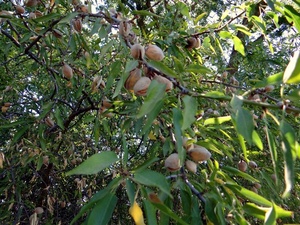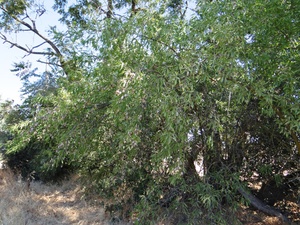 Unpicked almonds on North Ashley Avenue. Photo by queerbychoice.Almond Trees are trees in section Amygdalus (Old World almonds, the species commonly sold in stores) and section Emplectocladus (New World almonds, such as the Southern California Desert Almond) of subgenus Prunus of genus Prunus of the Amygdaleae tribe of the Amygdaloideae subfamily of the rose family. Old World almonds are extremely closely closely related to peach trees. The genus Prunus also contains plum trees, apricot trees, and cherry trees.
Unpicked almonds on North Ashley Avenue. Photo by queerbychoice.Almond Trees are trees in section Amygdalus (Old World almonds, the species commonly sold in stores) and section Emplectocladus (New World almonds, such as the Southern California Desert Almond) of subgenus Prunus of genus Prunus of the Amygdaleae tribe of the Amygdaloideae subfamily of the rose family. Old World almonds are extremely closely closely related to peach trees. The genus Prunus also contains plum trees, apricot trees, and cherry trees.
More distantly related, but also in the Amygdaloideae subfamily of the rose family, is the Maleae tribe, which includes apple trees, pear trees, hawthorn trees, cotoneaster, photinia, and toyon.
California produces 80% of the world's almond supply, and almonds are California's most valuable export crop.1 The leading almond-growing counties in California are Kern, Fresno, Stanislaus, Merced and Madera Counties. Although Yolo County is not a leading producer of commercial almonds, almonds can easily be grown here.
 Almond (Prunus dulcis) on North Ashley Avenue. Photo by queerbychoice.Almond (Prunus dulcis) is a deciduous tree from the Mediterranean region. It is the source of the almonds commonly sold in grocery stores. It usually grows 15 to 40 feet tall. It has "perfect" flowers (containing both male and female parts). It is ranked 10 out of 10 on the Ogren Plant Allergy Scale, indicating a tendency to cause very severe hay fever. An allergic reaction to almond pollen is usually not accompanied by an allergic reaction to eating almonds. Almond trees typically bloom from about February through April, so if you suffer from hay fever during those months, almond trees could be the culprits.
Almond (Prunus dulcis) on North Ashley Avenue. Photo by queerbychoice.Almond (Prunus dulcis) is a deciduous tree from the Mediterranean region. It is the source of the almonds commonly sold in grocery stores. It usually grows 15 to 40 feet tall. It has "perfect" flowers (containing both male and female parts). It is ranked 10 out of 10 on the Ogren Plant Allergy Scale, indicating a tendency to cause very severe hay fever. An allergic reaction to almond pollen is usually not accompanied by an allergic reaction to eating almonds. Almond trees typically bloom from about February through April, so if you suffer from hay fever during those months, almond trees could be the culprits.
An almond tree is planted in Woodside Park.


